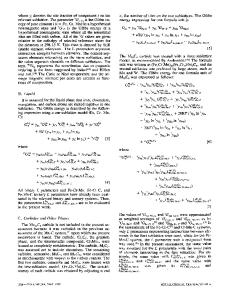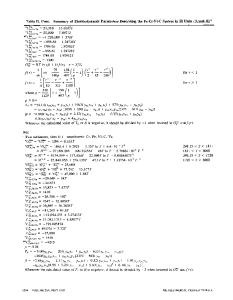A thermodynamic evaluation of the Fe-Cr-C system
- PDF / 907,000 Bytes
- 10 Pages / 613 x 788.28 pts Page_size
- 83 Downloads / 428 Views
I.
INTRODUCTION
THEFe-Cr-C system has been experimentally investigated many times over the years. However, most of the older investigations are somewhat unreliable due to poor analyzing techniques or insufficient purity of the alloys. The experimental studies considered in the present evaluation start with Hultgren and Kuo, 1 who investigated the bcc/ cementite ((Fe, Cr)3C) equilibrium at 973 K. Later Kuo 2 extended the study to include the bcc/(Fe, Cr)7C 3 and b c c / ( F e , Cr)23C6 equilibria. In the present report these carbides will be referred to as M7C3 and M23C6. Further investigations of the isothermal section at 973 K were published by Jellinghaus and Keller 3 and Leibner et al. 4 Ko et al. 5 and Lindblad 6 added new data to the knowledge of the bcc/cementite equilibria at 973 K and lower temperatures. Recently Wada 7 performed an experimental study at 985 K covering the b c c / M 7 C 3 equilibria and gave the first information on the isoactivity lines for carbon in bcc. The result indicates a strong influence of chromium on the carbon activity with a Wagner interaction of eccr = - 7 2 --- 2. Sharma et al. s provided some new information at 973 K and in addition they studied the fcc/bcc and fcc/cementite equilibria at 1023 and 1043 K. Woodyatt and Krauss 9 published an isothermal section at 1143 K, but doubts must be raised regarding their micro-probe data since they were not able to account for more than 90 to 95 pct of the elements in some of their alloys. Bungardt et al. io.H carded out two extensive studies of various equilibria at several temperatures. The isothermal equilibria at 1273 K were studied by Nishizawa and Uhrenius ~2 and by Benz et al., 13 who also provided data for tie-lines at 1373 K. Hertzman 14 made experiments on the b c c / f c c / M 2 3 C 6 equilibrium at 1273 K. Various authors have published carbon activity measurements at different temperatures. Among those are Sch~rmann et al.,15 Nishizawa,16 Schuler and Erkes, 17 Brandis et al., TM Wada et al., 19 and Greenbank. 2~ Earlier investigations of the solid state equilibria have been reviewed by Chipman and Brush. "~ In the survey of the literature it became evident that there is no report giving the carbon activity of an fcc twophase equilibrium in combination with the compositions of both phases. That kind of information would be very powerful in an assessment of the thermodynamic properties of the system. Another area where experimental information seems to be lacking is the solid state at temperatures higher than 1373 K. There is a special need for information JAN-OLOF ANDERSSON, on leave from the Division of Physical Metallurgy, Stockholm, Sweden, is Research Assistant, Ceramic Division Bldg. 223/A229, National Bureau of Standards, Gaithersburg, MD 20899. Manuscript submitted January 20, I987. METALLURGICALTRANSACTIONSA
on the composition of coexisting phases, With this in mind it was decided to include some exploratory experiments of important equilibria at 1473 K in the present work, although the main purpose was to assess
Data Loading...











